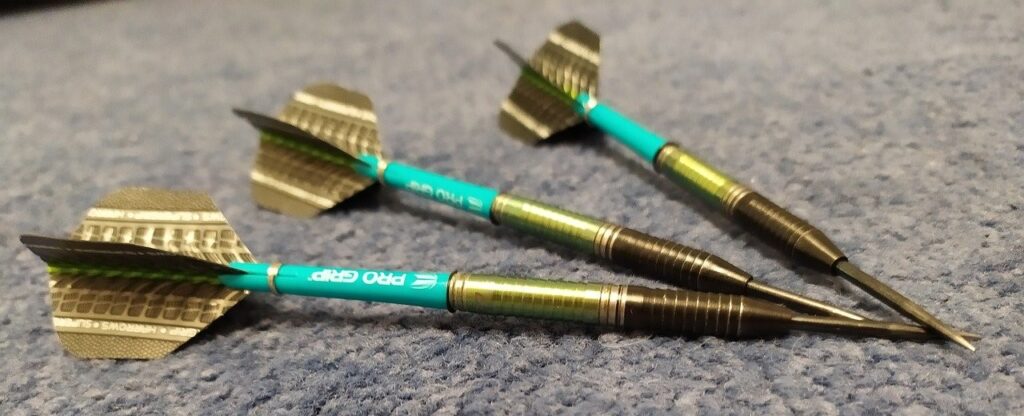Deciding which dart flights to use can be very confusing as there are loads of different variables such as the shape, size and material, but one variable that is often overlooked is the thickness of the flight. In this article, I’ll be comparing thick and thin dart flights and the pros and cons of each so you can decide which flight thickness to try next.
The Quick Answer
Dart flight thickness affects the stability of the dart. Thicker flights provide more stability making them useful for softer throwers and darts with longer stems. Dart flights are typically 75-150 microns thick but most players prefer to use flights that are between 75-120 microns thick.
How Thick Are Dart Flights?
Foldable dart flights are between 75-150 microns thick, with the average being around 100 microns. Moulded dart flights are much thicker and are typically 300-400 microns thick. Dart flight thickness is measured in microns which is 1/1000th of a millimetre.
Most brands will describe their dart flights as either thin, standard, thick, extra thick or super thick. The thickness in microns that these terms refer to varies from brand to brand, so look out for the actual number instead of the description.
Check out this table listing the most popular foldable flight thicknesses and some examples.
| Foldable Flight Thickness | Rating | Examples |
| 75 microns | Thin/ Standard | Harrows Dimplex Standard, Unicorn Core Standard Plus, One80 Picture Flights Standard |
| 100 microns | Thick/ Extra Thick | Bulls Powerflite Standard, Unicorn Ultrafly Standard, Harrows Graflite Standard |
| 125 microns | Extra Thick | Unicorn Super Maestro Fin |
| 150 microns | Super Thick | Target Pro 150 Vision, Bulls One50 Standard, Pentathlon HD150 |

Does Flight Thickness Matter?
The thickness may not seem like the biggest factor to consider when selecting flights, however it often makes a lot more difference than most players expect.
The thickness of a dart flight affects the stability of the dart and the durability of the flight itself. Thicker flights offer more stability, but can be prone to taking more damage from incoming darts compared to thinner flights which are more flexible and will bend out of the way when hit by another dart.
Flight Thickness Affects Stability
If you’ve never changed the thickness of your dart flights, then the chances of you noticing a significant difference in the way the dart moves through the air is likely to be quite high. This is the case even when switching from 75 micron to 100 micron flights, as even this 25% increase is actually quite large.
The thickness of the flight impacts how stiff or flexible the dart is. Thicker, and hence, stiffer flights offer more stability compared to thinner flights. This means you’ll get less “fishtailing” in the air when the dart travels from your hand to the board.
Considering the Durability
The impact of thickness of the durability of the flight can be a bit of a debate. Generally, I’m of the opinion that thinner flights are more flexible and are more likely to bend out of the way of incoming darts so take less of a beating and last a bit longer.
Conversely, thicker flights are more likely to stand their ground and consequently get a bit more battered. There’s also the argument that thicker flights are more durable and less likely to misshape because they are more sturdy though.
However, it’s definitely the case that thinner darts are more likely to flex and move out of the way when hit by another dart. This may slightly help you fit more darts in smaller areas such as the trebles, doubles and bullseye, because the incoming darts are less likely to be knocked off their path by stiffer flights.
Although, the impact this makes is incredible minimal so I wouldn’t worry about it when making your decision.
What Flight Thickness Should I Use?
If you’re currently adjusting your setup, then you’ll probably realise already that there isn’t a “one-size fits all” answer here. There are many different variables that flight thickness needs to be considered alongside including the shape, size and material, and that’s just the flights!
You need to consider what you want out of your setup and then adjust accordingly.
For example, are you currently finding your darts to be a bit unstable during their flight path which you think is limiting your accuracy. If so, then try using some thicker flights.
But remember, that all the other components of your dart will come into play here, so changing another aspect may actually be a better approach. That’s why dart setups are usually very experimental.
However, I appreciate that’s not entirely helpful so here are some guidelines of pairings that work well.
- Thick flights work well with longer shafts to increase stability
- Thin flights work well with shorter shafts to increase speed
- For maximum stability, use thicker and larger flights
- If you’re a fast thrower, thinner flights are usually more suitable
- Thicker flights suit heavier darts more than thinner flights
Here are some more articles you should check out if you’re looking to change your setup:
Where to Start?
If you’re a complete beginner, I recommend starting with 100 micron thick flights. These are considered standard and give you a good starting point for you to make adjustments in the future without being at either extreme to begin with.
Top Picks
Here is a great flight to try out for beginners.
Harrows Retina
- Excellent quality
- Sleek design
- 100 microns thick
- Standard shape
Here are some more articles you might find useful:
